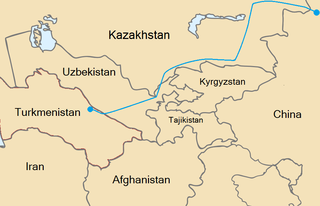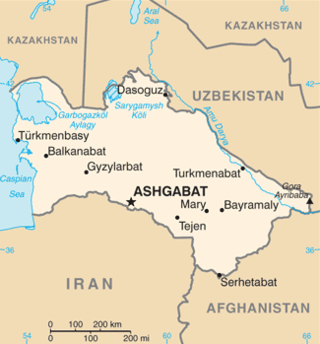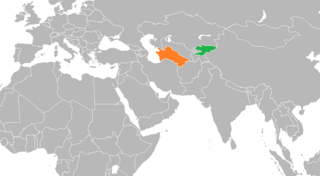
Central Asia is a region of Asia bounded by the Caspian Sea to the southwest, European Russia to the northwest, China and Mongolia to the east, Afghanistan and Iran to the south, and Siberia to the north. It includes Kazakhstan, Kyrgyzstan, Tajikistan, Turkmenistan, and Uzbekistan. The countries as a group are also colloquially referred to as the "-stans" as all have names ending with the Persian suffix "-stan" in both respective native languages and most other languages.

Ashgabat is the capital and largest city of Turkmenistan. It lies between the Karakum Desert and the Kopetdag mountain range in Central Asia, approximately 50 km away from the Iran-Turkmenistan border. The city has a population of 1,030,063.

Turkmen is a Turkic language of the Oghuz branch spoken by the Turkmens of Central Asia. It has an estimated 4.3 million native speakers in Turkmenistan, and a further 719,000 speakers in northeastern Iran and 1.5 million people in northwestern Afghanistan, where it has no official status. Turkmen is also spoken to lesser varying degrees in Turkmen communities of Uzbekistan and Tajikistan and by diaspora communities, primarily in Turkey and Russia.

The Central Asia–China gas pipeline is a natural gas pipeline system from Central Asia to Xinjiang in the People's Republic of China. By connecting Turkmenistan to China’s domestic grid, this pipeline makes it possible to transport gas some 7000 km from Turkmenistan to Shanghai. More than half of Turkmen natural gas exports are delivered to China through the pipeline.

Architecture of Central Asia refers to the architectural styles of the numerous societies that have occupied Central Asia throughout history. These styles include a regional tradition of Islamic and Iranian architecture, including Timurid architecture of the 14th and 15th centuries, as well as 20th-century Soviet Modernism. Central Asia is an area that encompasses land from the Xinjiang Province of China in the East to the Caspian Sea in the West. The region is made up of the countries of Kazakhstan, Uzbekistan, Tajikistan, Kyrgyzstan, and Turkmenistan. The influence of Timurid architecture can be recognised in numerous sites in Kazakhstan and Uzbekistan, whilst the influence of Persian architecture is seen frequently in Uzbekistan and in some examples in Turkmenistan. Examples of Soviet architecture can be found in Uzbekistan, Kazakhstan, Tajikistan and Kyrgyzstan.
The Humanitarian Association of World Turkmens or GATM is the organization meant to bring together Turkmen people in Turkmenistan and other parts of the world.

The Central Asian Union (CAU), later called the Central Asian Economic Union (CAEU), was an intergovernmental organization for economic integration between the Central Asian post-Soviet republics of Kazakhstan, Kyrgyzstan and Uzbekistan between 1994 and 2004. Tajikistan joined the Union in 1996 as an observer. Several proposals to restore the Union have been put forward since its dissolution.

The following outline is provided as an overview of and topical guide to Turkmenistan:

The Republic of Uzbekistan has an embassy in Ashgabat. Turkmenistan has an embassy in Tashkent. Both countries were previously subordinated republics of the Soviet Union as Turkmen Soviet Socialist Republic and Uzbek Soviet Socialist Republic before its collapse in 1991.

A Turkmen rug is a type of handmade floor-covering textile traditionally originating in Central Asia. It is useful to distinguish between the original Turkmen tribal rugs and the rugs produced in large numbers for export mainly in Pakistan and Iran today. The original Turkmen rugs were produced by the Turkmen tribes who are the main ethnic group in Turkmenistan and are also found in Afghanistan and Iran. They are used for various purposes, including tent rugs, door hangings and bags of various sizes.

The State Museum of Turkmenistan, also known as the Saparmurat Turkmenbashi Museum, is a museum in Ashgabat, Turkmenistan. The museum was opened on 12 November 1998. The museum has seven permanent galleries incorporating history, present day culture, and ethnography.
Durdy Bayramov was a Turkmen academician and artist who was awarded the highest honorary title in his country: "People's Artist of Turkmen SSR". In his native Turkmen language, Durdy Bayramov's name is simply "Durdy Bayram". The name "Bayram" means "celebration" in Turkic languages.

The 2017 Asian Indoor and Martial Arts Games, which is also counted as the 5th Asian Indoor Games, was held in Ashgabat, Turkmenistan in 2017. It became the third city in the former Soviet countries to win the right of hosting an Olympic Council of Asia-sanctioned event, following Astana and Almaty in Kazakhstan, which jointly-hosted the 2011 Asian Winter Games. The host city was chosen in Kuwait on 19 December 2010. On 6 July 2013 the flag of the Olympic Council of Asia was officially handed over to the mayor of the city of Ashgabat.
Armenians in Central Asian states: Uzbekistan, Kazakhstan, Kyrgyzstan, Tajikistan and Turkmenistan, were mainly settled there during the Soviet era for various reasons.

Turkmenistan has 4,980 kilometres (3,090 mi) of railways. The railway operator is the state owned company Türkmendemirýollary. The company belongs to the Ministry of Railways of Turkmenistan. Turkmenistan is currently expanding its rail system to cover 5,256.25 kilometres (3,266.08 mi) more distance, which will take its network to 10,236.25 kilometres (6,360.51 mi) track kilometres by 2025.
Tourism is a small industry in Turkmenistan, serving just over 14,000 visitors in 2019. Tourist destinations include World Heritage Sites, museums, and natural sites. Many of its Central Asian cities were main points of trade on the Silk Road, linking Eastern and Western civilizations. Many neighboring countries promote their countries based on their location along the Great Silk Road. Tourists from abroad are deterred by the restrictive visa policy regime with all countries of the world. Tourism is regulated by the Tourism Committee of Turkmenistan.
Teke is a major and politically influential tribe of Turkmens in Turkmenistan.

The Kazakhstan–Turkmenistan border is 413 kilometres (257 mi) in length and runs from the Caspian Sea to the tripoint with Uzbekistan. It is the shortest international boundary of both states.

The Turkmenistan–Uzbekistan border is the border between the countries of Turkmenistan and the Republic of Uzbekistan. At 1,793 km, it is Turkmenistan's longest border and Uzbekistan's second longest. The border runs from the tripoint with Kazakhstan to the tripoint with Afghanistan.

The two central Asian countries have shared relations for centuries, having previously been part of the former Soviet Union. The relations between the two nations mainly include economic, diplomatic and cultural ties. Both Kyrgyzstan and Turkmenistan are Turkic nations with similar cuisines, languages and cultures.
















